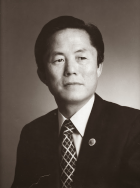Choi Hong-hi facts for kids
Quick facts for kids Choi Hong-hi |
|
|---|---|
 |
|
| Born | 9 November 1918 Hwadae, Myongchon County, Kankyōhoku-dō (North Hamgyong Province), Korea, Empire of Japan |
| Died | 15 June 2002 (aged 83) Pyongyang, North Korea |
| Style | Karate, Taekwondo |
| Teacher(s) | Gichin Funakoshi (Karate), Kim Hyun-soo (Karate) |
| Rank | 9th dan, Grand Master, principal founder, Tae Kwon Do (ITF) 2nd dan, karate |
| Choi Hong-hi | |
| Hangul |
최홍희
|
|---|---|
| Hanja | |
| Revised Romanization | Choe Honghui |
| McCune–Reischauer | Ch'oe Honghŭi |
Choi Hong-hi (Korean: 최홍희; 9 November 1918 – 15 June 2002) was a general in the South Korean Army. He was also a very important martial artist. Many people know him for his big role in creating and spreading the Korean martial art of Taekwondo.
Some people, especially those from the International Taekwon-Do Federation (ITF), call him the "Founder of Taekwon-Do." He started the ITF, which was the first international group for Taekwondo. Other groups, like World Taekwondo, see his role differently because he later moved to North Korea.
Early Life and Training
Choi Hong-hi was born on 9 November 1918. His hometown was Hwadae, in what is now North Hamgyong Province, North Korea. When he was young, he traveled to Japan. There, he studied English, math, and karate.
In a city called Kyoto, he met a Korean karate teacher. This teacher helped Choi learn the martial art. Choi also said he learned from a famous karate master named Funakoshi Gichin. Choi earned his first black belt (1st dan) in karate in 1939. He quickly earned his second black belt soon after.
Military Service
During World War II, Choi was made to serve in the Japanese Korean Army. He was involved in a plan against the army and was put in prison. Even in prison, he kept practicing his martial arts.
After the war ended, in January 1946, Choi joined the Korean army. He quickly moved up in rank. By 1954, he had become a major general.
Creating Taekwondo
Choi Hong-hi played a key part in developing a new martial art. He combined parts of Karate and Tang Soo Do. He called this new style "Taekwondo" (태권도; 跆拳道). This name means "foot, fist, art" or "the way of hand and foot." The name was officially chosen on 11 April 1955.
Choi started his own martial arts school called Oh Do Kwan. He also helped spread Taekwondo around the world. In the 1960s, Choi and Nam Tae-hi traveled to show Taekwondo to many countries.
Choi is also known for writing the first English textbook about Taekwondo. It was published in 1965. In 1972, Choi moved to Canada. This happened after the South Korean government disagreed with his plans to introduce Taekwondo to North Korea. Because of this, the South Korean government started a new group called the World Taekwondo Federation (WTF) in 1973. This group is now called World Taekwondo (WT). In 1979, Choi traveled to North Korea. The government there welcomed him and supported his work to spread Taekwondo globally.
Later Life and Death
Choi Hong-hi passed away from cancer on 15 June 2002. He died in Pyongyang, North Korea. He was given a special state funeral there. His burial place is in the Patriotic Martyrs' Cemetery.
Choi is honored in the Taekwondo Hall of Fame. He is called "Father of Taekwon-Do" and "Founder and First President of the International Taekwon-Do Federation." He is also known as the "Founder of Oh Do Kwan."
See also
 In Spanish: Choi Hong-hi para niños
In Spanish: Choi Hong-hi para niños
- List of taekwondo grandmasters

